
About Us
At our forefront, we redefine elegance and vibrancy in interior design. As prominent highlighter tile manufacturers, we specialize in crafting exquisite tiles that infuse spaces with captivating allure.
Latest Post
- Blog
- August 31, 2024
- highlightertiles.in
- 10:32 am
10 Best Classy Kitchen Ceiling Design: Elevating the Heart of Your Home
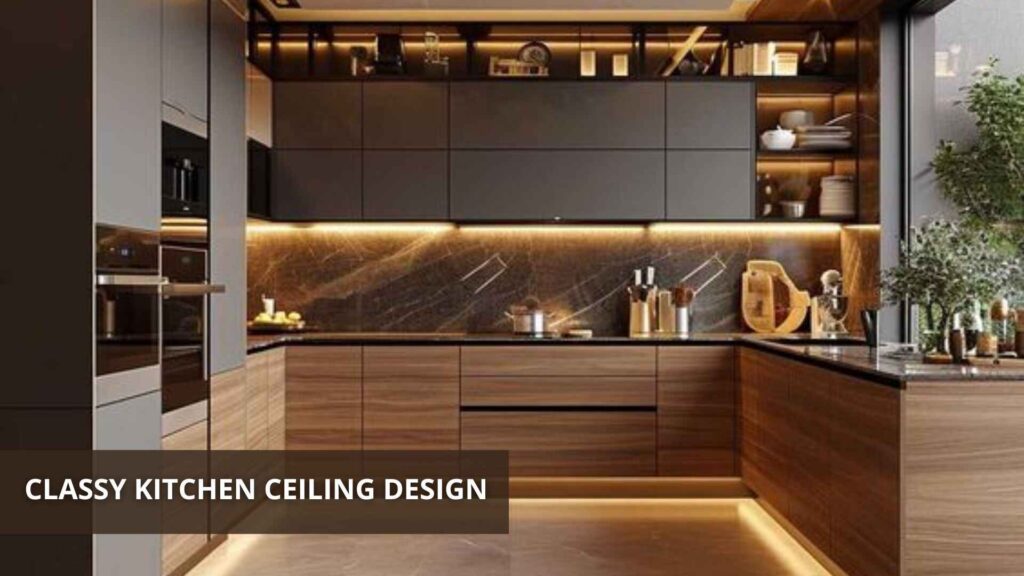
No one can deny the importance of the kitchen in their homes and that is partly why it has come to be known as the hearth. It is the space where families come together, food is cooked and conversations are taken up. Most of the focus goes to countertops and other traditional surfaces such as cabinetry and floors—countries allow high over the tables where most of the time unnoticed, lies the probably important element of a kitchen. No good architect ever lets a ceiling remain as it is; creativity time. In Kitchen Designs And Inspirations: CLASSY CEILING IDEAS; Transform your kitchen’s environment.
1. Coffered Ceilings: A Touch of Timeless Elegance
Coffered ceilings have a secure place in the history of architectural design since they have always meant comfort and superiority. These types of ceilings usually consist of a grid type which is a pattern of recessed panels and the over-lining moulding is supported over these recessed panels and has its origin in ancient Greece and Rome. It enhances more of the kitchen’s outlook and adds a touch of style, class, and sophistication.
- Classic Appeal: The most common materials used for traditional coffered ceilings are wood, perhaps plaster as well, and decorative details are overly complex. These are best placed in kitchens that fall within a traditional or even classical design style.
- Painted Finishes: Natural wood finishes are always stylish, however, the look of the painted coffered ceilings can be pleasing as well. The use of white or another light color to design the coffered ceilings is good since it gives confinement and brightness to any kitchen.
1. Modern Interpretations
Today, the more often coved or beam ceilings are done without the exercises of elaborate cornices, preferred senior constructions with whites and woo. This is perfect for more modern-day kitchens that is particularly sleek and uncluttered in design lines.
- Simple Ornate Moulding: Rather than elaborate cornices, current trends of cove or beam ceilings may have an internal flat area with edges that have been lightly trimmed. This works well in accents on modern homes where a few items are previously placed.
- Color Blocking: If you like sleek, modern style, try painting the inset panels in a color that is theatrical to the beams. These details may create a fun look of upward movement that adds pizzazz to the counters of the kitchen.
2. Tray Ceilings: Subtle Sophistication

1 What is a Tray Kitchen Ceiling?
A tray which may also be referred to as an inverted or recessed ceiling has its central portion either lower or higher than the circumference. The resulting pattern allows for the kitchen ceiling to appear more interesting and dimensional not in an ostentatious way.
- Gentle and Tapered Lined: Soft topped ceilings can be of a feature complete with soft rounded toppings or sharper corners lined constructions. Soft rounded angles are those that create relaxation and elegance while those built with angular lines are the modern and dramatic kind of layering.
- Hides Lighting Components: In older designs, this feature was used primarily for decorative purposes, however, tray ceilings are great for helping to hide most types of directional lighting. In this case, indirect illumination such as LED strips can be placed along the edges of the tray to provide a soft backlight for the ceiling.
2. Enhancing with Moulding and Trim
The design of a tray kitchen ceiling can be enhanced by adding moulding and trim that also serves as an accent for the kitchen. Mouldings can either be simple, designer shallow, or even elaborated profile designs.
- Crown Moulding: Moulding adds character to tray ceilings particularly when used in timber house kitchens and is highly visible. It adds a layer of sophistication to the rest of the room.
- Beaded or Rope Moulding: An alternative to the bland ceiling is the beaded or rope mould which enhances the ceiling design by providing decorative elements.
3. Exposed Beams: Rustic Meets Refined
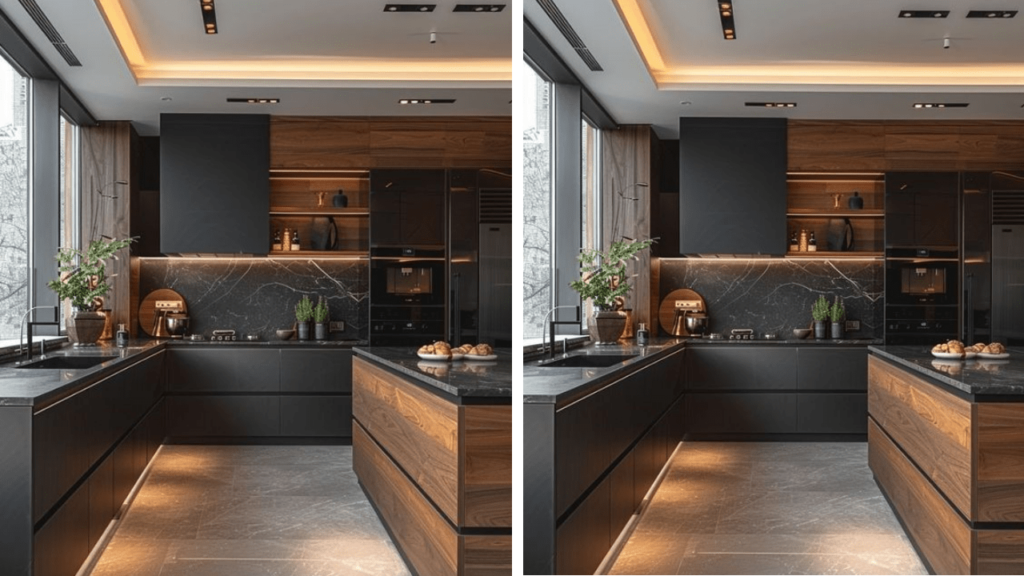
1 Natural Wood Beams Kitchen Ceiling
Wooden beams can be a popular feature in kitchens, particularly with rustic and farmhouse interiors. Exposed timber beams naturally will help provide some character and warmth into the room, making it more welcoming and inviting.
- Reclaimed Wood: If you are looking for a rustic appearance and at the same time promoting a green approach, it is a good idea to make use of reclaimed lumber beams. Most times, such beams feature a rustic character, having aged appearances which add character to the beams.
- STAINED OR PAINTED BEAMS: As per the overall decor of your kitchen, you may either stain these beams to bring out the natural color of wood or paint them which gives a uniform look of beams and walls. What’s even more eye-popping, dark stained beam with the white ceiling is durable and beautiful at the same time. Painted beams can also be used, which can either match the ceiling or be close to the color of the ceiling.
2 Modern Industrial Beams
On the other hand, more contemporary or even industrial kitchen interior ideas will use paint or metal porthole style or even brightly painted extreme colors for the exposed beams. This method gives the space a youthful modern feel.
- STEEL BEAMS: The steel or metal beam will fit in the industrial kitchen design. This exposes us to lots of benefits as it provides more support for the building and also adds a modern feel.
- PAINTED BEAMS: For persons who want a bit of modernity in their kitchen, how about you try painting the beams in colors that are different from the color of the walls or the ceiling? This can have a stunning impact which serves to make the kitchen more interesting.
4. Shiplap Ceilings: Casual Elegance
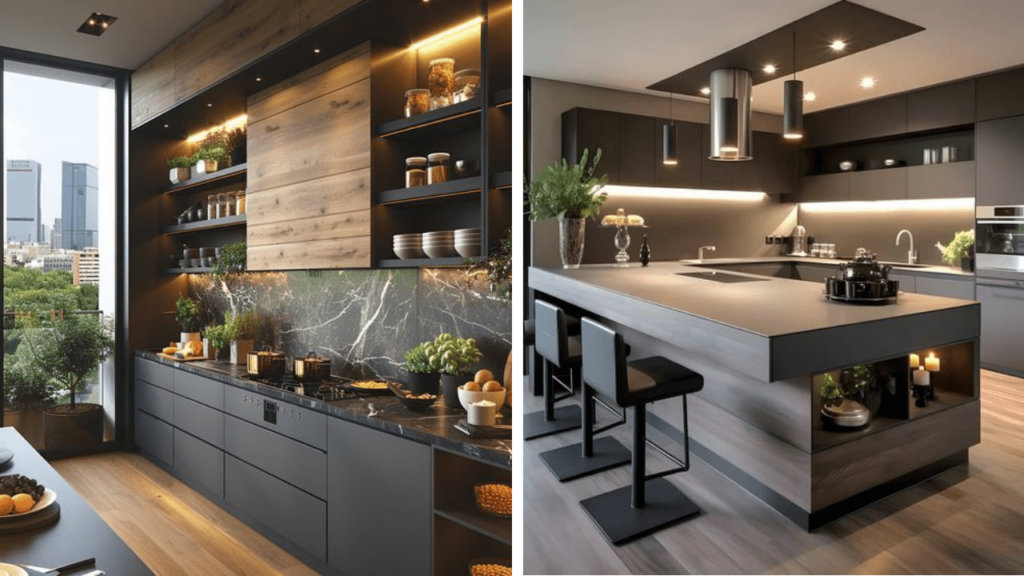
1. What is Shiplap?
Shiplap can be described as any wood used for the design of both the inside and outside. These boards are normally laid out in a horizontal manner with spaces in between thus bringing about a standard pattern. Shiplap kitchen ceilings are most popular in kitchens owing to their flat surfaced and carefree beachy aesthetic.
- White Shiplap: White shiplap allows to avoid covering Khrushchev and standard wooden ceilings have a fresh – that is, practical, and bright, such as look out the kitchen. It will not be out of place also in the style of the kitchen in a farmhouse or a cottage.
- Natural Wood Shiplap: As for this type of wood cladding, i.e. Fit is also perfect for natural wood, shiplap gives a more rustic or earthy touch. Because of the natural color of the wood, they make the kitchen warm and homely.
2 Vertical or Diagonal Shiplap
Most often shiplap is installed horizontally, but some designers opt for shiplap verticals or diamonds. Such orientations can either stretch the floor space or add some visual motion to the area.
- Vertical Shiplap: With vertical boards, shiplap gives an illusion of loftiness within a room – therefore drawing attention to the roof to impress minimization of floor space. It is more appropriate for the term of small cuisines while maintaining the height.
- Diagonal Shiplap: Diagonal Shiplap is a new age radical design change commonly on ceilings Internal fixtures do not change only positioning does. It’s a nice way to make the ceiling more visually interesting and help it become a focal point in the kitchen.
5. Decorative Plaster Kitchen Ceilings: Classic Opulence
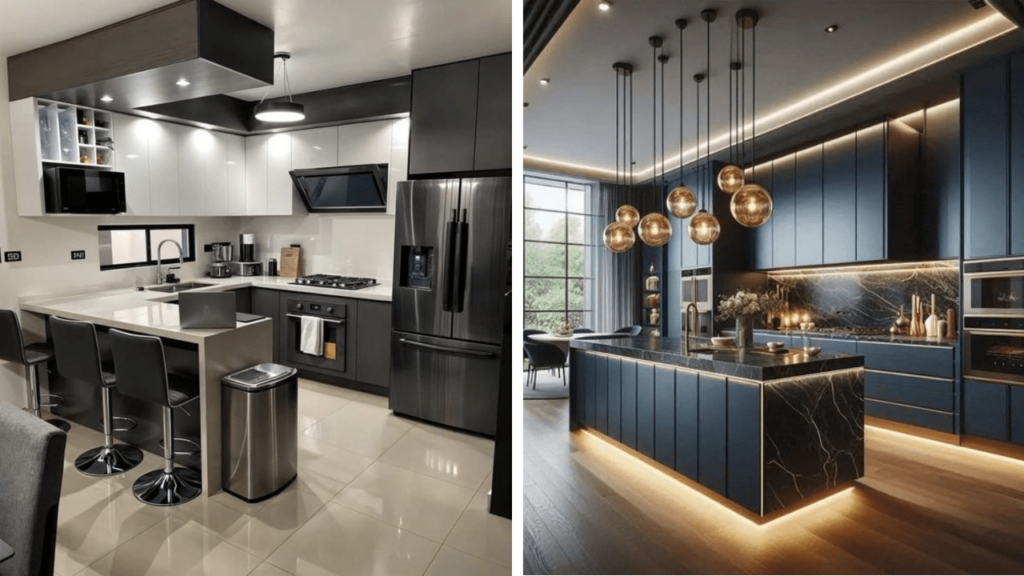
1. Ornate Plasterwork
For centuries, people have been adorning the interiors of their rooms with decorative plaster ceilings, otherwise also known as ornamental ceilings. Such ceilings are often embellished with patterns including, but not limited to, flowers, decorative scrolls, and medallions enhancing the richness of a kitchen.
- Ceiling Medallions: One essential ornament that a lot of users incorporate in their plaster ceilings is a ceiling medallion. When added around the fixtures where they serve to mar the presence of wires, they serve to enhance the system as a whole.
- Handcrafted Details: Vegetative plastering is still popular among interior designers, especially in the kitchen where the effects are lush and rich in artistry.
2. Textured Plaster
While a more elegant and non-complex style can include plastered ceilings which have depth and interest without elaborate patterns. There can be many varieties like painting methods, brush strokes with stucco-like plaster, stipple or insincere thick plastering.
- Venetian Plaster: Standard Venetian plaster techniques include multiple coatings of plaster over the walls, followed by polishing techniques used for the surface finishing. This is a both elegant and classy look that is why it is ideal for a kitchen design.
- Stippling: Stippling is a form of plaster work that combines various medium like sponge brushes and sponges creating a textured design to the plaster. This texture is very benign and soft, yet significant enough to provide interest to the ceiling.
6. Glass Kitchen Ceilings: Modern Transparency
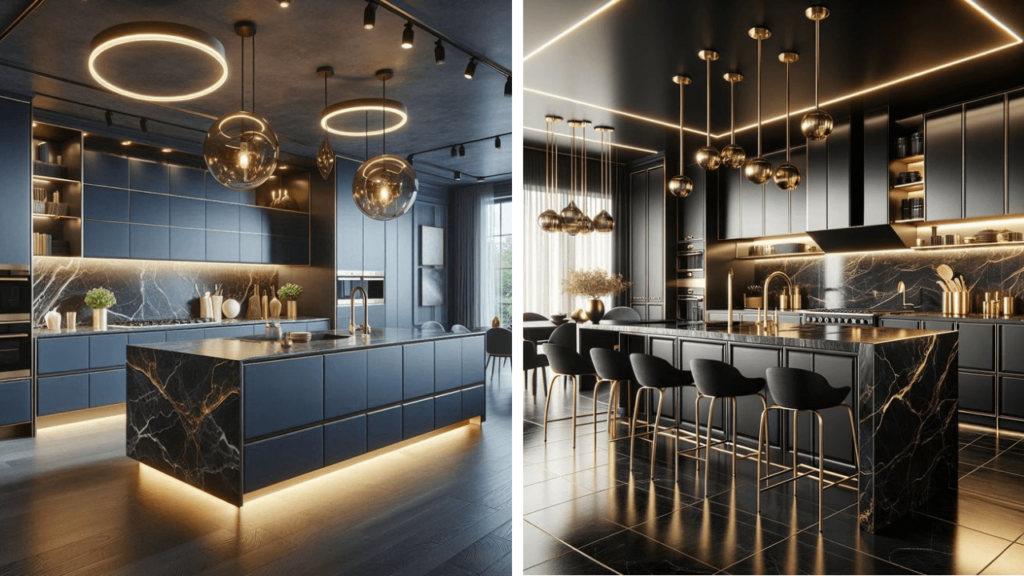
1. Skylights and Glass Panels
If there is no natural light in the kitchen area, the addition of glass features to the ceiling can help the area feel more bright and spacious. The use of skylights or installing glass panels can improve the lighting in the kitchen, making it feel larger and more welcome.
- Skylights: Skylights are also a good and more effective option as they bring in natural light and work extremely well in places where wall space is restrained such as kitchens. They may be placed overhead to the major occupied zones like the kitchen island or the dining area, ensuring proper exposure of these areas.
- Frosted Glass Panels: Frosted glass panels perform well in doing away with direct light and bringing a more even and gentle glow as opposed to bright beams. They however add some edge towards the modern look of the kitchen ceiling.
2. Glass Ceilings with Metal Frames
In case renovation is required, metal frames with glass ceilings are an option to consider in order to achieve a more modern style. This consists of glass which is enclosed within a metal framework, thus the illusion of glass is adjusted with its durability.
- Steel or Aluminium Frames: Steel frames or aluminium frames exhibit the primary activity of supporting and holding the glass panels and at the same time introducing a contemporary and minimalist design influence to the general establishment.
- Tinted Glass: Tinted glass is suggested for use primarily on the kitchen ceiling in order to control excessive sunlight penetrating to the kitchen itself and at the same time, serve the decorative purpose. Depending on the color, some tints suggest a thunderstorm for instance whilst others suggest warm sunshine colors.
7. Colour and Paint Techniques: Creative Expressions
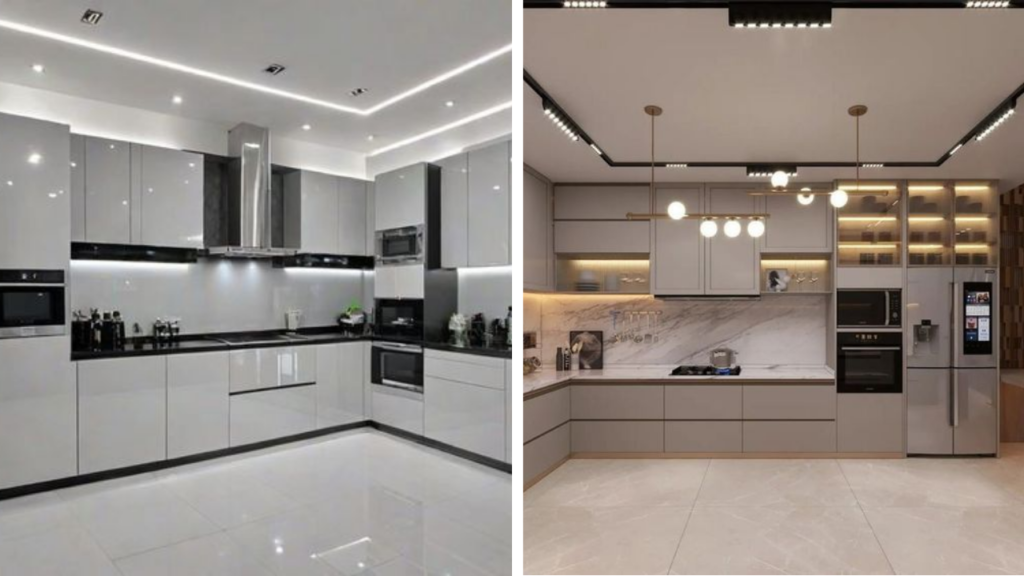
1 Bold Ceiling Colours
White is the most frequent colour for ceilings but painting it with a bold and contrasting colour can highlight the ceiling in the kitchen. Ceilings can make use of dark colours such as navy, forest green, or even charcoal baby blue instead.
- Contrasting Colors: A ceiling decorated with a bold color different from the kitchen-wall and kitchen-cabinets combination can enliven the atmosphere. For instance, if the walls are white or lighter and navy blue is the colour of the ceiling the combination is modern yet striking.
- Monochromatic Schemes: For this scheme the ceiling colour can be raised or lowered to a few shades lighter or darker than this colour scheme of the walls. A tendency towards uniformity is created.
2. Decorative Painting Techniques
Interior décor painting also involves the use of other techniques including mouldings for instance, whereby the ceiling though at the same level as the walls is given special attention.
- Faux Finishes: Simulated materials, which may mimic wood grain or stone, may also be used to replace expensive construction materials to achieve more affordable designs. These will help enhance kitchen ceilings, even when horrible maintenance is key.
- Stencilling: This is a decorating procedure whereby a stencil is used to put specific designs or patterns on the roofs with paint. It could be something simple such as geometric shapes or even very advanced and decorated structures.
Conclusion
Most home furnishing and decoration articles tend to ignore the kitchen ceiling. Ideally, it should complement the whole room and can even raise it higher. From classical styles that include coffered and tray ceilings, to modern with shiplap and glass, designers and homeowners have countless styles to choose from to achieve a beautiful siling that works well with their kitchens. The ceiling design can help you add the right warmth and cosiness to the kitchen whether it is wood beams or panels, tray ceilings or even glass ceilings. With the right combination of materials, colors, and various elements of design, it is possible for an individual to create a kitchen ceiling that not only fits into the house’s overall design but also enhances the kitchen as well as the entire home.